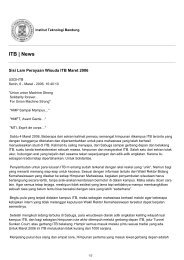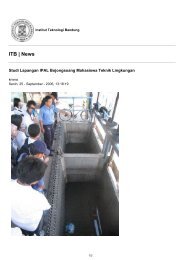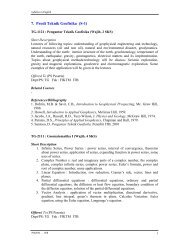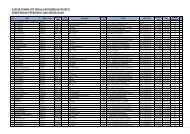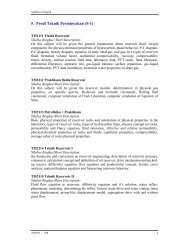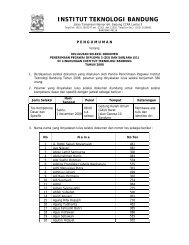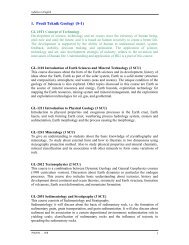Silabus MBA ITB 1 1. MM7000 â Financial Management Objectives ...
Silabus MBA ITB 1 1. MM7000 â Financial Management Objectives ...
Silabus MBA ITB 1 1. MM7000 â Financial Management Objectives ...
Create successful ePaper yourself
Turn your PDF publications into a flip-book with our unique Google optimized e-Paper software.
<strong>1.</strong> <strong>MM7000</strong> – <strong>Financial</strong> <strong>Management</strong><br />
<strong>Objectives</strong><br />
: <strong>1.</strong> to give understanding and perspective on financial<br />
management function in the company and in its relation<br />
to domestic and international economy.<br />
2. To give ilustration on financial management practices<br />
and policies, processes, techniques and strategies that are<br />
used in the financial management.<br />
3. To develop knowledge on the type and characteristics of<br />
problems and the possibility of the occurrence of<br />
financial management problems, and to increase the<br />
ability to handle the problems through reliable approach<br />
and problem solving strategy development.<br />
4. To develop planning skill and monitoring skill in<br />
financial management functions effectively, so the<br />
students be able to apply the appropriate management<br />
strategy to face the company challenges.<br />
Short Descriptión : Preface, Company <strong>Financial</strong> Report Analysis, Company<br />
<strong>Financial</strong> Environment, Fundamental Concept in <strong>Financial</strong><br />
<strong>Management</strong> in term of risk and revenue, Portfolio Theory<br />
and Money Value over Time, Strategic Investment Decision,<br />
Capital Budgeting Process and Technique, Security and<br />
Company Evaluation, Strategic Marketing Decision, Capital<br />
Structure and Capital Cost, Tactical Financing Decision<br />
through IPO, Lease Financing and Hybrid Financing,<br />
Working Capital <strong>Management</strong>, Derivatives and Risk<br />
<strong>Management</strong>, Company’s Success and Failure.<br />
References<br />
: <strong>1.</strong> Arthur J. Keown, John D. Martin, J. William Petty &<br />
David F. Scott, Jr. (2005), <strong>Financial</strong> <strong>Management</strong>;<br />
Principles and Applications,Tenth Edition, Pearson<br />
Prentice Hall.(KMPS)<br />
2. Robert F Bruner (2003), Case Studies in Finance;<br />
Managing for Corporate Value Creation, Fourth Edition,<br />
McGraw - Hill Irwin, Boston.(CSIF)<br />
3. Stephen A. Ross, Randolph W. Westerfield & Jeffrey<br />
Jaffe (2005), Corporate Finance, Seventh<br />
Edition,McGraw-Hill, Boston.(RWJ).<br />
4. Zvi Bodie, Alex Kane & Alan J. Marcus, (2005),<br />
Investments, Sixth Edition, McGraw-Hill.(BKM)<br />
<strong>Silabus</strong> <strong>MBA</strong> <strong>ITB</strong> 1
2. MM60E4 – Knowledge Creation and Information Technology<br />
<strong>Objectives</strong><br />
: After completing this course, the students should be able to:<br />
<strong>1.</strong> Understand the importance of learning organization in<br />
the knowledge/information era.<br />
2. Understand the scope in Knowledge Creation and<br />
Information Technology’s role problems in learning<br />
organization.<br />
3. Understand the effects of dominant factors in knowledge<br />
creation or the learning organization establishment<br />
process.<br />
4. Act as a good leader or has capability to make correct<br />
decision in order to create a fertile habitat to construct<br />
learning organization or in organization knowledge<br />
creation process.<br />
Short Descriptión :<br />
<strong>1.</strong> Change paradigm and knowledge in information era.<br />
2. Concept and essence of Learning Individual – evoke<br />
Capital Psychology potential<br />
3. Concept and essence of knowledge and human as human<br />
capital organization.<br />
4. Essence of Knowledge Creation in Learning<br />
Organization,<br />
5. The essence of leadership, Learning Culture, and<br />
Information Technology and System in developing<br />
learning organization<br />
References<br />
: <strong>1.</strong> Hackett, Brian, “Beyond Knowledge <strong>Management</strong>: New<br />
Ways to Work and Learn”, The Conference Board Inc<br />
Survey Report<br />
2. Harvard Business Review (1998) On Knowledge<br />
<strong>Management</strong>, Harvard Business School Press,<br />
Cambridge, Mass.<br />
3. Sarkar, Reena J., & Bandyopadhyay, S, (2001)<br />
“Developing an Intranet-based Knowledge <strong>Management</strong><br />
Framework in a Consulting Firm: A Conceptual Model<br />
and its Implementation”, PricewaterhouseCoopers.<br />
4. Sveiby, Karl-Erik, (2001) “A Knowledge-based Theory<br />
of the Firm to Guide Strategy Formulation”, Article for<br />
Journal of Intelellectual Capital vol 2, Nr4.<br />
<strong>Silabus</strong> <strong>MBA</strong> <strong>ITB</strong> 2
3. MM7004 – People <strong>Management</strong> & Organizational Behavior<br />
<strong>Objectives</strong> :<br />
<strong>1.</strong> The students are able to understand on how human<br />
behave in work situation, and how the company increase<br />
employees’ productivity effectively through employee’s<br />
behavior training.<br />
2. The students are able to understand on how to manage<br />
human resource in the company so the company’s goal<br />
can be achieved effectively. How the planning was done,<br />
how to obtain human resource through recruitment and<br />
how to develop the human resources to increase their<br />
productivity.<br />
3. The students are able to apply the behavior and people<br />
management concept.<br />
4. The students are able to understand and master in<br />
developing the concepts learned so they may improve the<br />
decision making in people management<br />
Short Descriptión : Organizational behavior is a study on how human interacts<br />
with other individuals in working situation, and how a group<br />
and organization structure affects individual behavior in an<br />
organization<br />
In current business environment, a manager needs to has<br />
attention on people management; what type of effective<br />
human resource management is needed to achieve<br />
sustainable competitive advantage. There are two goals in<br />
this lecture, first is to develop a clear understanding on<br />
People <strong>Management</strong>. Second, to develop background skills<br />
in people management.<br />
References<br />
: Coleman, Andiel, Bantam (2000), Working with Emotional<br />
Intelligence.<br />
Noe, R.A., Hollenbeck, J. R., Gerhart, B. and Wright, P.M.<br />
(2004) Human Resource <strong>Management</strong>: Gaining<br />
Competitive Advantage 4 th Ed., McGraw Hill Irwin.<br />
Punnet, Jane Betty (2004), International Perspective on<br />
Organizational Behavior and Human Resource<br />
<strong>Management</strong>, armonk, NY:M.E. Sharpe.<br />
Schermerhorn, Hunt, and Osborn (2003), Organizational<br />
Behavior (8th ed.), John Wiley and Sons, Inc.<br />
<strong>Silabus</strong> <strong>MBA</strong> <strong>ITB</strong> 3
4. MM70P1 – Project <strong>Management</strong><br />
<strong>Objectives</strong><br />
: After completing this course, students should be able to:<br />
a. Understand concept of business project for domestic and<br />
international environment.<br />
b. Make a decision through implementing scientific tools to<br />
guarantee project efficient, under control and cost<br />
conscious.<br />
c. Understand and develop a learning concept to improve<br />
managerial decision making on certain project.<br />
d. Posses extra insight about building, executing and<br />
terminating of a project.<br />
e. Manage a project on medium or top managerial level to<br />
achieve designated target.<br />
Short Descriptión : <strong>1.</strong> Project Magement Concept<br />
2. Project Planning<br />
3. Project Implementation<br />
4. Human Aspect in a Project<br />
5. Project Termination<br />
References<br />
: <strong>1.</strong> Cleland, David I. and Ireland, Lewis R. (2002), Project<br />
<strong>Management</strong>: Strategic Design and Implementation, 4 th<br />
Ed., McGraw-Hill, London..<br />
2. Meredith, Jack R. and Mantel, Samuel J. Jr. (2003),<br />
Project <strong>Management</strong>: A Managerial Approach, Wiley,<br />
Hoboken, New York<br />
<strong>Silabus</strong> <strong>MBA</strong> <strong>ITB</strong> 4
5. MM60E7 – Risk <strong>Management</strong><br />
<strong>Objectives</strong><br />
: in the end of course, it is targeted that:<br />
<strong>1.</strong> Students know risk management basic concepts consist<br />
of both risks that are affected by company’s external and<br />
internal factors.<br />
2. The students are able to implement or make a decision<br />
by using concept (know how) of risk identifying, to<br />
measure or assesment of risk, and to do risk mitigation,<br />
whether originated from company’s action or third<br />
party’s, in term of insurence, hedging, or other aspects.<br />
3. The students are able to understand and develop the<br />
previously learned concept (know why) so they are able<br />
to improve the managerial decision making quality about<br />
risk management and using derivatives to minimize risk,<br />
or using business diversification or portfolio.<br />
Short Descriptión : The topics that will be discussed in this Risk <strong>Management</strong><br />
lecture:<br />
a. Preface (overviewof Risk <strong>Management</strong>)<br />
b. The difference of the meaning of risk, business risk and<br />
risk type (price risiko,credit risk, pure operational risk)<br />
c. Risk <strong>Management</strong> Process (identification, measurement,<br />
risk handling and monitoring)<br />
d. Risk Anayises and its application in a company (in<br />
operation <strong>Management</strong>, Finance, and Marketing)<br />
e. Handling Method and decision making in risky situation<br />
f. Risk reduction through diversification, insurance,and<br />
hedging<br />
g. Company’s Risk <strong>Management</strong> Principles<br />
h. Risk <strong>Management</strong> Case Study:<br />
- Risk Quantifying<br />
- <strong>Financial</strong> Risk <strong>Management</strong> can icrease value to<br />
shareholders<br />
- Organization behavior and leadership<br />
- Corporate strategy and operation and organization<br />
risk management strategy<br />
- Business process<br />
- Hedging Strategy through Short sale and option<br />
- Entrepreneurship and Marking process risk<br />
- Social Entreprise and Ethics<br />
- Operation <strong>Management</strong><br />
- Competitive Strategy in crises<br />
- Multinational company controlling foreign exchange<br />
value<br />
- Marketing Risk<br />
- Integrated Risk <strong>Management</strong><br />
<strong>Silabus</strong> <strong>MBA</strong> <strong>ITB</strong> 5
References : <strong>1.</strong> Evans, James R. & Olson, David L. (2002);<br />
“Introduction to Simulation and Risk Analysis”, Prentice<br />
Hall.<br />
2. Greene, Mark R. & Trieschmann, James S. (1988); “Risk<br />
and Insurance”, South-Western Publishing Co.<br />
3. Harrington, Scott E. & Niehaus, Gregory R. (1999);<br />
“Risk <strong>Management</strong> and Insurance”, Irwin-McGraw-Hill.<br />
4. Olsson Carl (2002); “Risk <strong>Management</strong> in emerging<br />
markets: how to survive and prosper”, Prentice Hall.<br />
5. Van Deventer, Donald R; Imai, Kenji; Mesler, Mark.<br />
(2005); “ Advanced <strong>Financial</strong> Risk <strong>Management</strong>”, Wiley<br />
Finance.<br />
6. Williams, JR. C. Arthur; Smith Michael L; Young, Peter<br />
C. (1998); “Risk <strong>Management</strong> and Insurance”,<br />
McGraw-Hill International 8 th edition.<br />
<strong>Silabus</strong> <strong>MBA</strong> <strong>ITB</strong> 6
6. MM-6002: <strong>Financial</strong> and <strong>Management</strong> Accounting<br />
<strong>Objectives</strong><br />
: <strong>1.</strong> to introduce students with an overview of the financial<br />
reporting systems.<br />
2. To create awareness among students of the need to<br />
understand financial accounting.<br />
3. To familiarize students with the roles of accounting in<br />
making business decisions.<br />
4. To expose students with financial reporting for different<br />
kinds of organization.<br />
5. To develop the ability to select relevant information<br />
needed for a particular situation.<br />
6. To enhance the ability to interact with financial staff to<br />
support his/her role in planning and control<br />
functions.<br />
Short description : Accounting is the language of business. Therefore,<br />
understanding the basics of accounting is an important<br />
requirement to be a good manager. Only by having a good<br />
grap of what accounting is about can management maintain<br />
their communication network effectively with the<br />
stakeholders.<br />
References :<br />
<strong>1.</strong> Anthony, R.N. & D.F. Hawkins & K.A. Merchant, 1999,<br />
Accounting: Text and Cases, 10 th edition, McGraw-Hill<br />
Book Co, Singapore<br />
2. Gray, Jack & Don Ricketts, 1982, Cost and Managerial<br />
Accounting, McGraw-Hill Book Co, Singapore<br />
3. Horngren, Datar, and Foster, 2003, Cost Accounting - A<br />
Managerial Emphasis, 11 th edition, Prentice-Hall, Inc.,<br />
Upper Saddle River, New Jersey<br />
4. Jiambalvo, James, 2001, Managerial Accounting, John<br />
Wiley & Sons, Inc., New York<br />
5. Matz, A. & M.F. Usry & L.H. Hammer, 1984, Cost<br />
Accounting: Planning and Control, 8 th edition, South-<br />
Western Publishing Co., Cincinnati, Ohio<br />
6. Smith, J.L. & R.M. Keith & W.L. Stephens, 1986,<br />
Accounitng Principles, 2 nd edition, McGraw-Hill Book,<br />
Inc., New York<br />
<strong>Silabus</strong> <strong>MBA</strong> <strong>ITB</strong> 7
7. MM7005 – Corporate and Business Strategy<br />
<strong>Objectives</strong><br />
: After completing this course, the students are expected to:<br />
<strong>1.</strong> Be able to analyze and diagnose business environment<br />
changes and company or business organization strategic<br />
advantages.<br />
2. Be able to formulate business and corporate strategy and<br />
company’s functional strategi in competition.<br />
3. Understand and be able to implement strategies relate to<br />
resources allocation, organization and planning system,<br />
as well as functiononal policy and leadership process in a<br />
company.<br />
4. Understand and be able to evaluate a strategy focusing<br />
on evaluation and company’s strategic control.<br />
5. Understand the strategic issues relate to technology<br />
management, innovation, small business and non-profit<br />
organization.<br />
Short Description : <strong>1.</strong> Basic Concepts of Strategic <strong>Management</strong><br />
2. Corporate Governance and Social Responsibility<br />
3. Environmental Scanning and Industry Analysis<br />
4. Internal Scanning: Organizational Analysis<br />
5. Strategy Formulation: Situation Analysis amd Business<br />
Strategy<br />
6. Strategy Formulation: Corporate Strategy<br />
7. Strategy Formulation: Functional Strategy and Strategic<br />
Choice<br />
8. Strategy Implementation: Organizing for Action<br />
9. Strategy Implementation: Staffing and Directing<br />
10. Evaluation and Control<br />
1<strong>1.</strong> Strategic Issues in Managing Technology and Innovation<br />
12. Strategic Issues in Entrepreneurial Ventures and Small<br />
Businesses<br />
13. Strategic Issues in Not-For-Profit Organizations<br />
References<br />
: <strong>1.</strong> Kaplan, Robert S. & Norton, David P. (2001), The<br />
Strategy-Focused Organization, Harvard Business<br />
School Press.<br />
2. Kaplan, Robert S. & Norton, David P. (2004), Strategy<br />
Map, Harvard Business School Press.<br />
3. Wheelen TL & Hunger JD (2004), Strategic<br />
<strong>Management</strong> and Business Policy, 9th ed., Pearson<br />
Prentice Hall, New Jersey.<br />
<strong>Silabus</strong> <strong>MBA</strong> <strong>ITB</strong> 8
8. MM 60M2 – Strategic Marketing<br />
<strong>Objectives</strong><br />
: After completing this course students should be:<br />
<strong>1.</strong> Understand relationship between corporate, business and<br />
marketing strategy<br />
2. Be able to carry out systematic market research<br />
3. Be able formulate market entry strategy, product<br />
strategy, pricing strategy, promotion strategy, and<br />
distribution strategy<br />
4. Be able combine those strategies into a marketing plan<br />
5. Be able define a set of criteria to control the plan<br />
Short Description : Marketing plays important role in a dynamic business<br />
environment. It helps companies to identify market<br />
opportunities and customer value, create new product,<br />
determine optimum price, and select suitable distribution<br />
channels. In order to formulate a sound and feasible<br />
marketing plan, managers need to execute a thorough<br />
analysis of market, product, and customers in a framework<br />
of corporate and business strategy. This course is designed to<br />
deliver knowledge needed to analysis and build strategic<br />
marketing sense for managers.<br />
References<br />
: <strong>1.</strong> Cravens, D.W., (2000), Strategic Marketing, Sixth<br />
Edition, McGraw-Hil<br />
2. Harvard Business School, Market Analysis<br />
3. Harvard Business School, Basic Quantitative Analysis<br />
for Marketing<br />
4. Kotler, P., (2003), Marketing <strong>Management</strong>, Eleventh<br />
Edition, Prentice Hall<br />
5. O’Guin, T.C., C.T. Allen, and R.J Semenik, (2003),<br />
Advertising and Integrated Brand Promotion, Third<br />
Edition, Thomson<br />
6. Walker, Jr., O.C.W., H.W. Boyd, Jr., J. Mullins, and J.C.<br />
Larreche, (2003), Marketing Strategy: a decision-focused<br />
approach, Fourth Edition, McGraw-Hill – Irwin<br />
<strong>Silabus</strong> <strong>MBA</strong> <strong>ITB</strong> 9
9. MM60M6 – Business and Competitive Intelligence<br />
<strong>Objectives</strong><br />
: After completing this course, students should:<br />
<strong>1.</strong> Understand (know what) competitive intelligence<br />
concept and know required process to build it<br />
2. Be able to use Competitive Intelligence in a highly<br />
competitive business environment, for example to<br />
develop a Competitive Intelligence organization in the<br />
company.<br />
3. Be able to understand and be able to develop previously<br />
learned concept (know why) to improve managerial<br />
decision making process relates to Business Intelligence.<br />
Short Description : <strong>1.</strong> Competitive Intelligence Concept<br />
2. Basic Techniques and Approach<br />
3. Information Sources<br />
4. Information Analyses Technique<br />
5. Competitive Intelligence System Development<br />
6. Espionage & Counterintelligence<br />
7. Ethical and Legal Aspect<br />
References:<br />
• Fuld, Leonard M (1995). The New Competitor Intelligence, John Wiley<br />
and Sons.<br />
• Pollard, Andrew (1999), “Competitor Intelligence: Strategy, Tools and<br />
Techniques for Competitive Advantages”<br />
<strong>Silabus</strong> <strong>MBA</strong> <strong>ITB</strong> 10
10. MM60M3 – Cunsumer Behavior<br />
<strong>Objectives</strong><br />
: General aims of this subject is to equip students with:<br />
A well understanding relates to consumer behaviour concept<br />
particularly in consumer marketing and B2B (Business to<br />
Business), and link it to marketing strategy a company<br />
should adopt<br />
Understanding of major models in consumer behaviour and<br />
be able to determine their relevance to particular<br />
marketing situations<br />
Knowledge in examining latest marketing trends and skill in<br />
developing aspects relate to significant changes in<br />
consumer behaviour and understand their implications to<br />
marketing strategy and programs<br />
Skill and knowledge in a real business competition<br />
addressing consumer behaviour issues by conducting a<br />
real business/marketing game (Cellular electronic<br />
voucher marketing)<br />
Abilities in applying consumer behaviour concepts in<br />
positioning, branding, marketing communication and<br />
advertising strategies.<br />
Knowledge in examining the influence of culture differences<br />
on consumer behaviour and marketing strategy<br />
Short Description : This subject is comprised of 7 modules:<br />
<strong>1.</strong> Consumer Behaviour & Marketing Strategy<br />
2. Dynamic Segmentation & Consumer Behaviour<br />
3. A model of consumer behaviour<br />
4. Factors affecting Consumer Behaviour in a micro<br />
marketing perspective<br />
5. The Buyer Decision Process and Types of Buying<br />
Decision Behaviour<br />
6. Positioning and Marketing Communication Conducted<br />
By Taking Into Account Consumer Behaviour<br />
7. Business to Business Behaviour<br />
References:<br />
<strong>1.</strong> Prescribed Text<br />
a. Craid-Less, M. Joy, S., & Browne, B., (1995), Consumer Behaviour, John<br />
Wiley & Sons, Singapore<br />
b. Kotler, P., Brown, L., Adam, S and Amstrong G., (2004), Marketing, 6 th<br />
edition, Pearson Education Australia, New South Wales<br />
c. Schiffman, L., Bednall, D., Cowley, E., O’ Cass A., Watson, J And<br />
Kanuk, L, (2001), Consumer Behaviour, 2 nd Edition, Pearson Education<br />
Australia, NSW<br />
<strong>Silabus</strong> <strong>MBA</strong> <strong>ITB</strong> 11
2. Recommended References<br />
a. Hass, Robert W. (1992), Business Marketing <strong>Management</strong> : An<br />
Organizational Approach, 5 th Edition, PWS-KENT Publishing Company,<br />
Boston<br />
b. Hofstede G. (1991), CULTURES AND ORGANISATIONS : Intercultural<br />
Cooperation and Its Importance for Survival – Software of the mind, Mc<br />
Graw-Hill International, London<br />
c. Keegan, Wareen J., & Mark C. Green (1997), Principles Of Global<br />
Marketing, Prentice Hall, New Jersey<br />
d. Peter, P. J., and Olson, J.C. (2005), Consumer Behaviour & Marketing<br />
Strategy, 7 TH Edition, McGraw-Hill/Irwin, New York<br />
e. Ries, A., Trout, J. and Temporal, P., (2003), The 22 Immutable Laws of<br />
Marketing in Asia, John Wiley & Son, Singapore<br />
f. Schiffman, L., Bednall, D., Cowley, E., O’ Cass A., Watson, J And<br />
Kanuk, L, (2001), Consumer Behaviour, 2 nd Edition, Pearson Education<br />
Australia, NSW<br />
<strong>Silabus</strong> <strong>MBA</strong> <strong>ITB</strong> 12
1<strong>1.</strong> MM7006 –Social Responsibilities and Business Ethics<br />
<strong>Objectives</strong><br />
: Equip students with knowledge in:<br />
<strong>1.</strong> Describing in detatil, cultural differences and similarities,<br />
religion, and gender in a domestic and global market that<br />
affect on managerial practise and business operation.<br />
2. Identifying the main strategy and challenges in local and<br />
global market as an effect of ethical values differences<br />
and principles that clung to cultural groups, religion, and<br />
gender.<br />
3. Developing strategic opportunity for the company in<br />
doing its business activities in local and global market in<br />
the existence of cultural differences, religion, and/or<br />
gender.<br />
4. Describing in detail the importance of social equity and<br />
corporate social responsibility initiatives in an<br />
organization and business operational activites.<br />
5. Understanding and respecting the values and principles<br />
that clung to the culture, religion, and/or gender that is<br />
not a personal belonging of the students.<br />
Short Description : <strong>1.</strong> Basic Philosophy on Business Ethics<br />
2. Good Governance and Finance Accountability<br />
3. Ethics and Marketing<br />
4. Corporate Culture<br />
5. Human and Social Capital<br />
6. Intelectual Property Rights<br />
7. Gender and Sexual Harrasment<br />
8. Corporate Social Responsibility<br />
9. Community development<br />
References : <strong>1.</strong> Harvard Business Review on Corporate Social<br />
Responsibility<br />
2. Joseph W. Weiss, (2003). Business Ethics: A Stake<br />
Holder and Issues <strong>Management</strong> Approach. Thomson-<br />
South Western, Canada<br />
3. Laura P. Hartman, (2005).Perspective in Business Ethics<br />
(third edition). Mc. Graw Hill International Edition. Mc<br />
Graw Hill, Singapore<br />
4. Arif Budimanta, et all, (2005). Coporate Social<br />
Responsibility: Jawaban Bagi Model Pembangunan<br />
Indonesia Masa Kini. Penerbit ICSD, Jakarta<br />
5. Bambang Rudito and Arif Bduimanta, (2003). Metode<br />
and Teknik Pengelolaan Community Development.<br />
Penerbit ICSD, Jakarta.<br />
<strong>Silabus</strong> <strong>MBA</strong> <strong>ITB</strong> 13
6. Paul Colier, (1998). Social Capital and Poverty. Social<br />
Capital Initiative Working paper No. 4. World Bank.<br />
7. Francis Fukuyama, (1995). Trust: The Social Virtues and<br />
the Creation of Prosperity. Hamish Hamilton, London.<br />
8. Peter Schwartz and Blair Gibb, (1999). When Good<br />
Companies Do Bad Things: Responsibility and Risk in<br />
an Age of Globalization. Jhon Wiley & Sons, Inc. New<br />
York<br />
9. Jhon Connel and Richard Howitt (ed), (1991). Mining<br />
and Indiginous Peoples in Australasia. Sydney<br />
University Press, Australia.<br />
10. Charles Hampden-Turner, Corporate Culture: From<br />
Vicious to Virtuuous Cisrcle (buku mas bambang tolong<br />
check lagi)<br />
1<strong>1.</strong> Reading Material on Intellectual Property Rights<br />
• The Protection of Intellectual Property in the United<br />
States (HBS 9-897-046)<br />
• Needed A New System of Intellectual Property Rights<br />
(HBR 97510)<br />
• Note on International Licensing (Ivey 9A96G008)<br />
12. Reading Material on Gender Issues:<br />
• Note of the Law of Sexual Harassment (HBS 9-398-<br />
024)<br />
• Sexual Harassment, Free Speech Or…? (HBS 9-393-<br />
033)<br />
• The Case of the Mismanaged Ms. (HBR 87614)<br />
<strong>Silabus</strong> <strong>MBA</strong> <strong>ITB</strong> 14
12. MM60E3 –Technology <strong>Management</strong> & New Product Development<br />
<strong>Objectives</strong><br />
: The students who complete from this course are hopefully<br />
able to understand and manage technology as corporate<br />
resource, which includes ability to plan the technology<br />
required; develop new product & technology required;<br />
manage technology strategy; manage technology transfer<br />
process, manage inovation process and technology R&D;<br />
and evaluate technology performance and impact, both for<br />
corporate business value and industry<br />
Short Description : To manage the technology (start from research &<br />
development phase to procurement & implementation phase<br />
in the company), to align it with corporate business strategy,<br />
maximize added value and support new product<br />
development<br />
References : <strong>1.</strong> Bulgerman, Maidique and Wheelwright. (2001).<br />
Strategic <strong>Management</strong> of Technology and Innovation.<br />
McGraw Hill. BMW.<br />
2. Harvard Business Case. HBC.<br />
3. Lehmann/Winer. (2002). Product <strong>Management</strong> 3/e. Mc<br />
Graw Hill. LW.<br />
4. Tjakraatmadja Jann Hidajat (1997), Manajemen<br />
Teknologi, Studio Manajemen – TI <strong>ITB</strong>. TJH.<br />
5. Tarek Khalil (2000). <strong>Management</strong> of Technology: The<br />
Key to Competitiveness and Wealth Creation. McGraw<br />
Hill. TK.<br />
<strong>Silabus</strong> <strong>MBA</strong> <strong>ITB</strong> 15
13. MM60E2 - Innovation <strong>Management</strong> and Entrepreneurship<br />
<strong>Objectives</strong><br />
: Students, who complete this course, hopefully will be able to<br />
have clear picture relate to entrepreneurs and their<br />
characteristics. The students are also able to get the lessons<br />
from the real entrepreneurs, either from direct discussions,<br />
from videos or from books. In the end of the course, students<br />
will be able to understand foundation for developing<br />
business plan and their major components<br />
Short Description : In this course, students will mostly have depth discussion on<br />
people aspects of business activity with the entrepreneurs<br />
that are invited to the school. The discussion includes<br />
entrepreneurships characteristics, leadership, trust, ethics and<br />
social responsibility and creativity. This course emphasis on<br />
foundation of business plan development for entrepreneurs.<br />
References<br />
: H & P: Hisrich & Peters: Entrepreneurship, 5c, McGraw-Hill<br />
<strong>Silabus</strong> <strong>MBA</strong> <strong>ITB</strong> 16
14. MM60M5 – Market Research<br />
<strong>Objectives</strong><br />
: The objective of this course is two folds: provide students<br />
with theoretical framework in selecting suitable market<br />
research methods and to give them practical experience of<br />
applying marketing research methods. The theoretical part is<br />
delivered through lecturing and business case analysis in<br />
class, while the practical one is conducted by inviting guest<br />
lecturers and involving students in real business case(s).<br />
Short Description : The following topics will be discussed in this course<br />
includes:<br />
- Steps in marketing research<br />
- Defining marketing research problem<br />
- Developing approach(es) to solve the problem<br />
- Research design<br />
- Measurement and scaling<br />
- Designing questionnaire<br />
- Sampling<br />
- Data collection and analysis<br />
- Reporting<br />
References<br />
: <strong>1.</strong> Burns, A.C. and R.F. Bush (2005), Marketing Research:<br />
online research applications, 4 th Edition, Prentice Hall<br />
2. Malhotra, N.K. and M. Peterson (200 ), Basic Marketing<br />
Research, Edition, Prentice Hall<br />
3. Malhotra, N.K. (2004), Marketing Research: an applied<br />
orientation, 4 th Edition, Prentice Hall<br />
4. Rhey, W.L. and F.M. Gryna (2001), Market Research for<br />
Quality in Small Business, Quality Progress, vol. 34, no.<br />
1, pp. 31-38<br />
<strong>Silabus</strong> <strong>MBA</strong> <strong>ITB</strong> 17
15. MM70P5 – Performance <strong>Management</strong> and Benchmarking<br />
<strong>Objectives</strong><br />
: The subject’s objective is to help managers understand the<br />
concepts, frameworks, and techniques that can be used to<br />
diagnosis an existing company competitiveness<br />
environment, identify its chalenges and opportunities, and<br />
formulate a contextual performance management system in a<br />
dynamic, distinctive operating improvements that directly<br />
affect the firms performance advantage in the marketplace.<br />
These framework, concepts and techniques can be applied<br />
not only in manufacturing but also in service operations.<br />
That is why the cases will be discussed is vary on type of<br />
companies includes manufacturing, education, non profit<br />
organisation and others.<br />
Short Description : Course topics will be studied and explored in 30 course<br />
sessions, consist of topics listed below.<br />
<strong>1.</strong> Managing company in the 21st century<br />
2. Comparison among performance management<br />
frameworks<br />
3. Integrated Performance <strong>Management</strong> Framework<br />
4. Company environmental scanning<br />
5. Company vision, mission statement<br />
6. Performance <strong>Management</strong> Variables: Company Result,<br />
Internal Business Process, Resource Availability<br />
7. Others Performance <strong>Management</strong> Framework (The<br />
Balanced Scorecard, Prism, and Malcolm Baldrige<br />
National Quality Award)<br />
8. Benchmarking<br />
9. Expert System in Performance <strong>Management</strong> Systems<br />
References<br />
: <strong>1.</strong> Wibisono, D (2006) Manajemen Kinerja: Konsep, Desain<br />
& Teknik Meningkatkan Daya Saing Perusahaan,<br />
Penerbit, Erlangga<br />
2. Neely, A., Adams, C. and Kennerley, M. (2002),<br />
Performance Prism: The Scorecard for Measuring and<br />
Managing Stakeholder Relationships, <strong>Financial</strong> Times<br />
Prentice Hall, Cambridge.<br />
3. Kaplan, R.S. Norton, D.P. and Lowes, A. (1996),<br />
Balanced Scorecard: Translating Strategy into Action,<br />
Harvard Business School Press, MA.<br />
4. Meyer, M.W. (2003), Rethinking Performance<br />
Measurement: Beyond the Balanced Scorecard,<br />
Cambridge University Press, and Cambridge.<br />
<strong>Silabus</strong> <strong>MBA</strong> <strong>ITB</strong> 18
16. MM6015 - Technology and Operations <strong>Management</strong><br />
<strong>Objectives</strong> : After completing this course, the students should be able<br />
to:<br />
Gain an appreciation of the strategic importance of<br />
formulating and implementing an operations<br />
management strategy.<br />
Gain a thorough understanding of creating competitive<br />
advantage by productivity improvement.<br />
Develop a skill set for identifying and solving problems<br />
of designing, planning, and managing operations.<br />
Short Description: The operations management course examines issues from<br />
product design, capacity planning, process flow and layout<br />
to inventory and quality control. This course covers a<br />
broad introduction to the field of operations management.<br />
The content includes operations strategy for competitive<br />
advantage, forecasting, new product and service<br />
development, design of goods and services, quality<br />
management, quality control tools for improving<br />
processes, process measurement and analysis, facility<br />
decisions: location and capacity, layout strategy, human<br />
resources issues, work performance measurement, supply<br />
chain management, inventory management, aggregate<br />
planning, material requirements planning, scheduling,<br />
project management, and just-in-time systems.<br />
References : <strong>1.</strong> Chase, R.B., Jacobs, F.R. and Aquilano, N.J. (2006),<br />
Operations <strong>Management</strong> for Competitive Advantage,<br />
11 th Ed., McGraw-Hill, Boston.(CJA)<br />
2. Cox, J.F., Blackstone, J.J. and Schleier, J.G. (2003),<br />
Managing Operations: A Focus on Excellence, North<br />
River Press, NY. (CBS)<br />
<strong>Silabus</strong> <strong>MBA</strong> <strong>ITB</strong> 19
17. MM60P2 – Operations Strategy<br />
<strong>Objectives</strong><br />
: Students being given knowledge:<br />
to understand theory and practice of operations<br />
strategy.<br />
to formulate operations strategy and its course of<br />
action.<br />
to be competent in analyzing the effectiveness of<br />
operations strategy.<br />
Short Description: Operations is increasingly seen as the area where the<br />
dynamic requirements of the marketplace and the<br />
developing capabilities of the organization’s resources<br />
must be reconciled. Building on concepts from strategic<br />
management, operations management, marketing and<br />
human resources, this course takes the students towards a<br />
rich and potent understanding of operations strategy. The<br />
course covers such topical issues as supply networks,<br />
capability development, learning and risk It also includes<br />
many international boxed examples from a wide range of<br />
industries.<br />
References :<br />
<strong>1.</strong> Slack, N. and Lewis, M. (2001), Operations Strategy,<br />
Prentice Hall, NY.<br />
2. Hayes, R.H. (2004), Pursuing the Competitive Edge:<br />
Operations, Strategy, and Technology, Wiley, NY.<br />
3. Lowson, R.H. (2004), Strategic Operations<br />
<strong>Management</strong>: The New Competitive Edge, Routledge,<br />
London.<br />
<strong>Silabus</strong> <strong>MBA</strong> <strong>ITB</strong> 20
18. MM70P1 – Project <strong>Management</strong><br />
<strong>Objectives</strong><br />
: Enhance students with knowledge and skills:<br />
To define the importance of project management in various<br />
business activities such as physical construction, R&D,<br />
new product development, quality improvements, and<br />
human resources.<br />
To understand the way to develop work breakdown structure,<br />
project scheduling, monitoring, and control, and project<br />
evaluation.<br />
To understand the role of the project manager to improve<br />
quality, cost effectiveness, and completion time.<br />
Short Description:<br />
References :<br />
This course covers project management concept, project<br />
planning, project scheduling, project controlling, project<br />
management techniques (PERT and CPM), project cost<br />
estimate, tender procedure, and project leadership.<br />
<strong>1.</strong> Meredith, J.R. and Mantel, S.J. (2003), Project<br />
<strong>Management</strong>: A Managerial Approach, Wiley, Hoboken,<br />
New York.<br />
2. Newbold, R.C. (1998), Project <strong>Management</strong> in the Fast<br />
Lane, Lucie Press, NY.<br />
<strong>Silabus</strong> <strong>MBA</strong> <strong>ITB</strong> 21
19. MM60P4 – Supply Chain <strong>Management</strong><br />
<strong>Objectives</strong><br />
: Enhance students with knowledge and skills:<br />
To understand concepts of creating competitive advantage through<br />
supply chain management.<br />
To understand the way to design, analyze, improve, and manage<br />
various types of supply chains.<br />
To diagnose supply chain problems and propose most effective<br />
solutions including ways to monitor performance progress.<br />
Short Description:<br />
The course includes supply chain management and<br />
competitiveness, logistics network configuration, demand<br />
planning, inventory management and risk pooling, the value of<br />
information, supply chain integration, supply chain mapping,<br />
supply chain systems analysis, strategic alliances, procurement<br />
and outsourcing strategies, international issues in SCM,<br />
coordinated product and supply chain design, customer value and<br />
SCM, and information technology for SCM.<br />
References :<br />
<strong>1.</strong> Simchi-Levi, D., Kaminsky, P. and Simchi-Levi, E.<br />
(2003), Designing and Managing the Supply Chain,<br />
Mc-Graw Hill, NY.<br />
2. Chopra, S. and Meindl, P. (2004), Supply Chain<br />
<strong>Management</strong>, 2 nd Ed., Prentice Hall, NY.<br />
<strong>Silabus</strong> <strong>MBA</strong> <strong>ITB</strong> 22
20. MM60P8 – Enterprise Resource Planning<br />
<strong>Objectives</strong><br />
: Enhance students with knowledge and skills:<br />
To understand concepts of creating competitive advantage through<br />
the implementation of ERP.<br />
To understand the way to design, analyze, select, and manage<br />
various processes of ERP software.<br />
To capitalize ERP in finding and solving problems in order to<br />
improve operational performance.<br />
Short Description:<br />
The primary purpose of this course will be to lay out the scope of<br />
ERP (Enterprise Resource Planning) Systems implementation,<br />
explain the competitive advantages of using ERP Systems and<br />
support general concepts with short case studies. This course<br />
covers the fundamental issues important in ERP implementation<br />
and management, starting from an information<br />
systems/information technology project management perspective.<br />
The course is accompanied with laboratory work using software<br />
product of IFS, in order to allow students to understand the<br />
process of ERP.<br />
References :<br />
<strong>1.</strong> Olson, D.L. (2003), Managerial Issues of Enterprise<br />
Resource Planning Systems, Mc-Graw Hill, NY.<br />
2. Davenport, T.H. (2000), Mission Critical: Realizing the<br />
Promise of Enterprise Systems, Harvard Business School<br />
Press, Boston.<br />
<strong>Silabus</strong> <strong>MBA</strong> <strong>ITB</strong> 23
2<strong>1.</strong> MM6004 – Decision Making<br />
<strong>Objectives</strong>:<br />
The students will be able to structuring management problems,<br />
generating alternatives, and selection of the optimal souliton.<br />
Short Description: Identify problems, generate alternatives, and structuring<br />
complex problems<br />
References:<br />
<strong>1.</strong> Keeney: Keeney, Ralph L. (1998). Value-Focused Thinking<br />
(VFT), Harvard University Press.<br />
2. PIDD : Pidd, M. Tools for Thinking.<br />
3. Gause : Gause, D.C, G.M. Weinberg (1990). Are Your Lights On?<br />
Dorset House Publishing.<br />
4. Hans: Daellenbach, H. (1994). Systems and Decision Making.<br />
John Wiley & Sons Ltd.<br />
5. Saaty: Saaty, T.L. (1988). Decision Making: The Analytic<br />
Hierarchy Process. British Library Cataloguing In Publication<br />
Data.<br />
6. Flood: Flood, R.L, M.C. Jackson (1991). Creative Problem<br />
Solving: Total Systems Internvention<br />
<strong>Silabus</strong> <strong>MBA</strong> <strong>ITB</strong> 24




